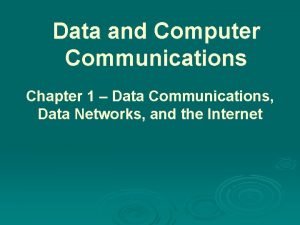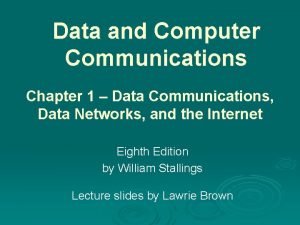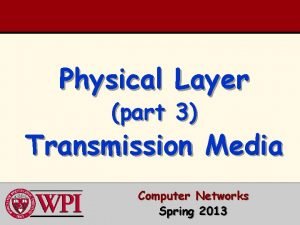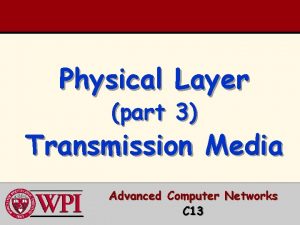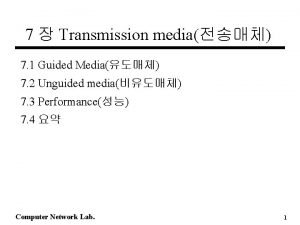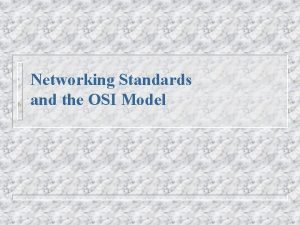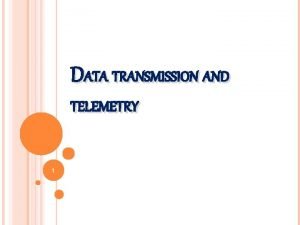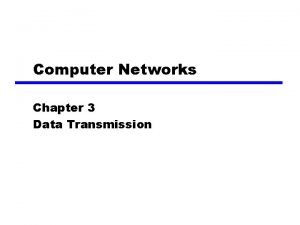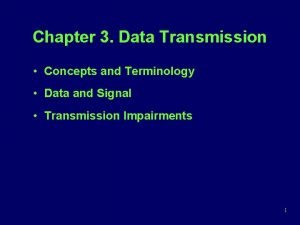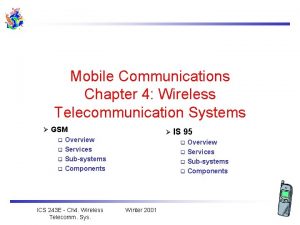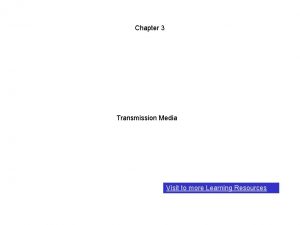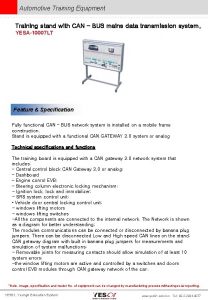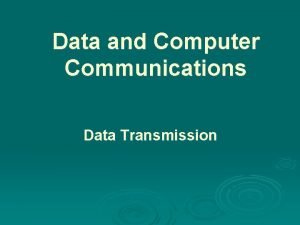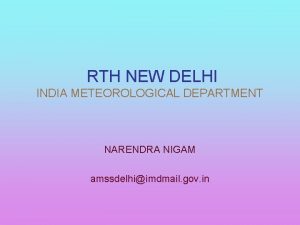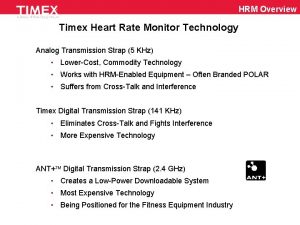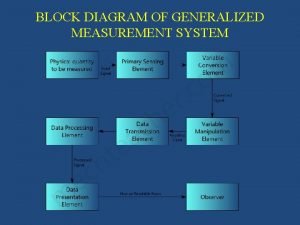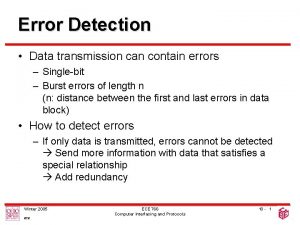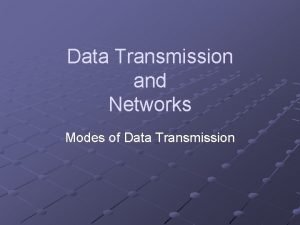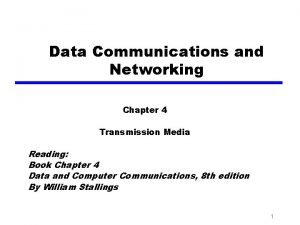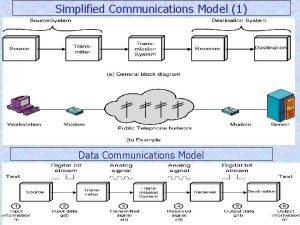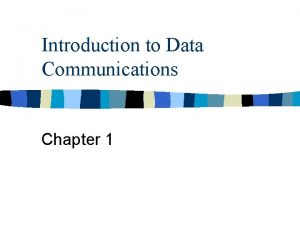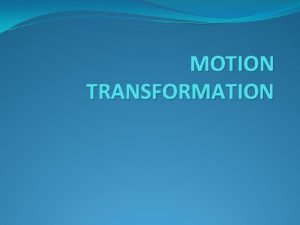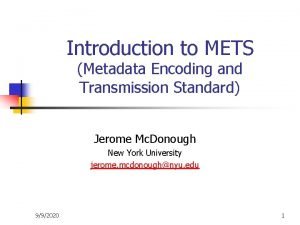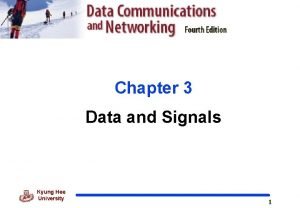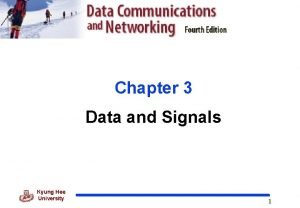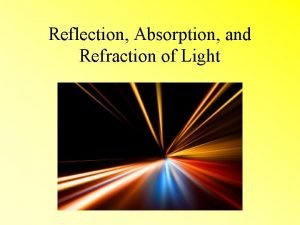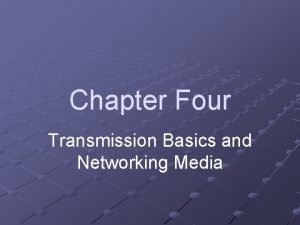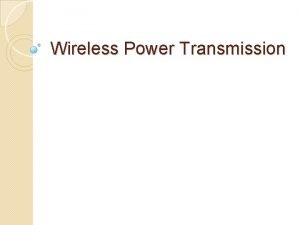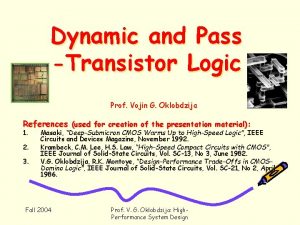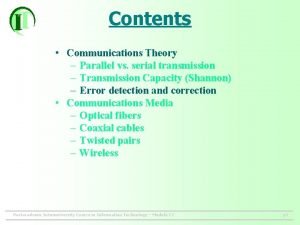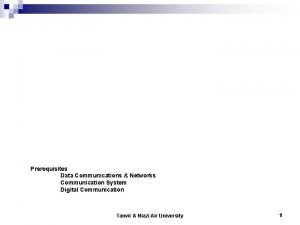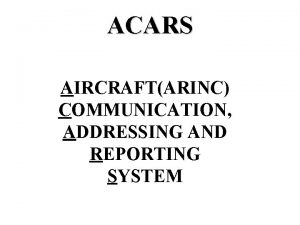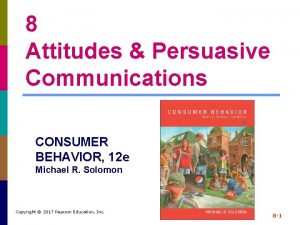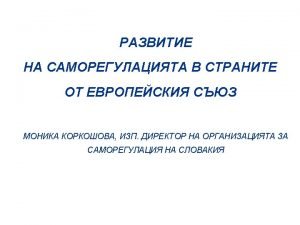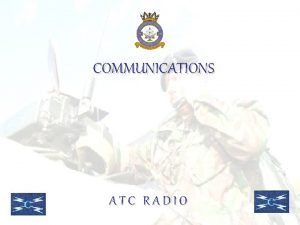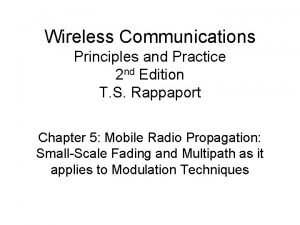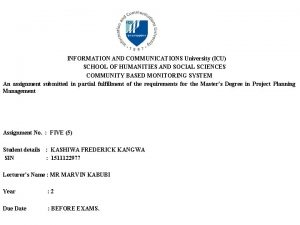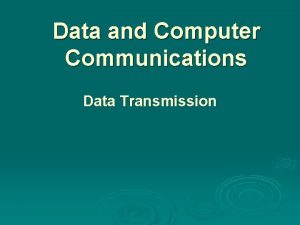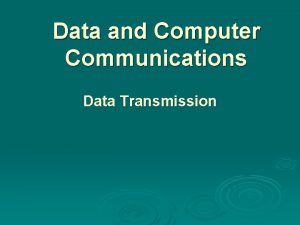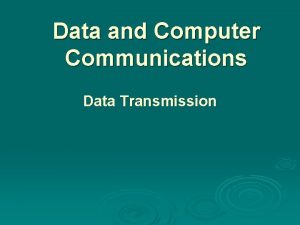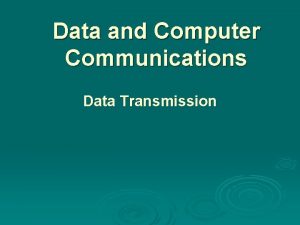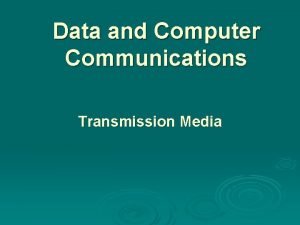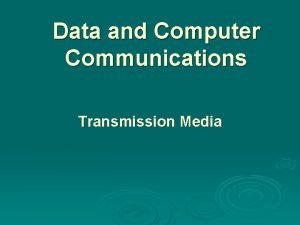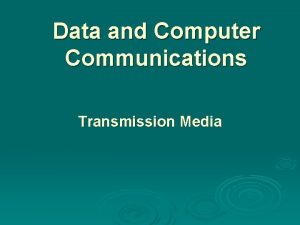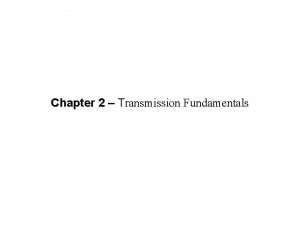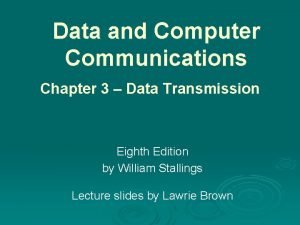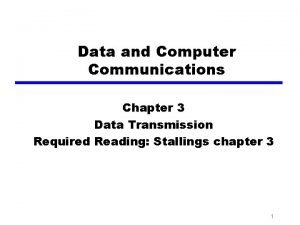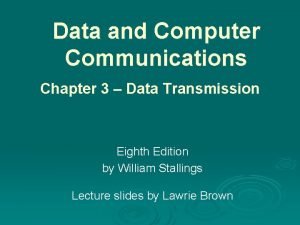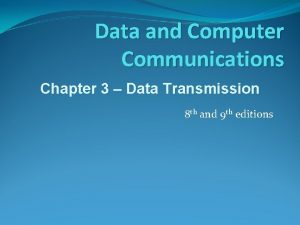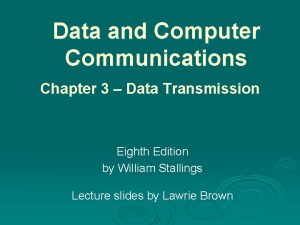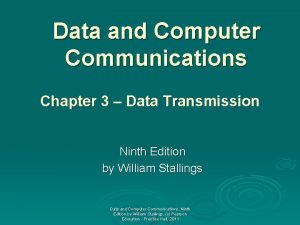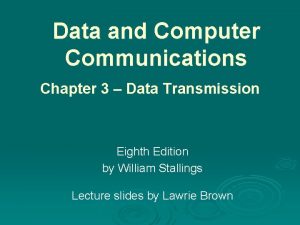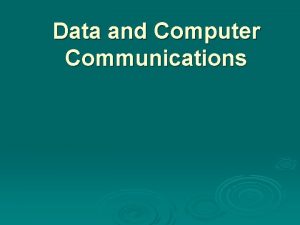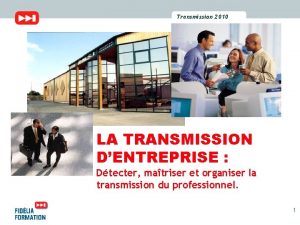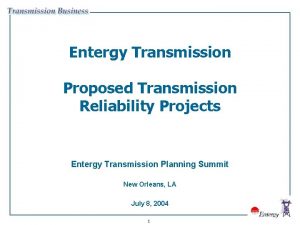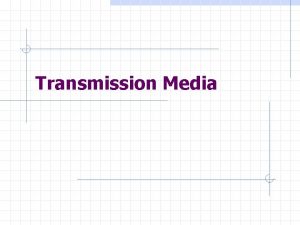Data and Computer Communications Chapter 3 Data Transmission












































































- Slides: 76

Data and Computer Communications Chapter 3 – Data Transmission Eighth Edition by William Stallings Lecture slides by Lawrie Brown

Data Transmission Ø The successful transmission of data depends on two factors: l l the quality of the signal being transmitted the characteristics of the transmission medium

Transmission Terminology-1 Ø data transmission occurs between a transmitter & receiver via some medium Ø guided medium l eg. twisted pair, coaxial cable, optical fiber Ø unguided / wireless medium l eg. air, water, vacuum

Transmission Terminology-2 Ø direct link l l no intermediate devices (other than amplifiers or repeaters) apply to both guided and unguided media Ø point-to-point l l direct link only 2 devices share link Ø multi-point l more than two devices share the link

Transmission Terminology-3 Ø simplex l one direction • eg. television Ø half duplex l either direction, but only one way at a time • eg. police radio Ø full duplex l both directions at the same time • eg. telephone

Electromagnetic Signal Ø Function of time l Ø Can also be expressed as a function of frequency l l Ø Time domain Signal consists of components of different frequencies Frequency domain For data transmission l Frequency domain >> Time domain

Frequency, Spectrum and Bandwidth Ø time domain concepts l analog signal • various in a smooth way over time l digital signal • maintains a constant level then changes to another constant level

Analogue & Digital Signals

Frequency, Spectrum and Bandwidth Ø time domain concepts l periodic signal • pattern repeated over time • s (t + T ) = s (t ) -¥ < t < + ¥ • Where T is the period of the signal l aperiodic signal • pattern not repeated over time

Periodic Signals

Sine Wave Ø peak amplitude (A) l l Ø frequency (f) l l Ø maximum strength of signal volts rate of change of signal Hertz (Hz) or cycles per second period = time for one repetition (T) T = 1/f phase ( ) l Measure of the relative position in time within a single period of a signal

Sine Wave Ø General sine wave l s (t ) = A sin(2 ft + ) Amplitude Frequency Phase Ø Note l 2 radians = 360° = 1 period

Varying Sine Waves s(t) = A sin(2 ft + )

Wavelength ( ) Ø is distance occupied by one cycle Ø between two points of corresponding phase in two consecutive cycles Ø assuming signal velocity v have = v. T Ø or equivalently f = v § especially when v=c § c = 3*108 ms-1 (speed of light in free space)

Frequency Domain Concepts Ø signal are made up of many frequencies Ø components are sine waves Ø Fourier analysis can shown that any signal is made up of component sine waves Ø where A 0 is the DC component, An, Bn are the harmonics and f 0 is the fundamental frequency. Ø can plot frequency domain functions

Frequency Domain Concepts Ø In practice, an electromagnetic signal will be made up of many frequencies Ø Note: l l l s(t) is composed of sine waves of frequencies f and 3 f Second frequency (3 f) is an integer multiple of the first (f) Total period of s(t) is equal to the period of the fundamental frequency

Frequency Domain Concepts + =

Frequency Domain Representations freq domain func of Fig 3. 4 c Ø freq domain func of single square pulse Ø

Spectrum & Bandwidth Ø spectrum l l Ø absolute bandwidth l Ø width of spectrum (2 f in Fig 3. 4 c) effective bandwidth l often just bandwidth l Ø range of frequencies contained in signal Fig 3. 4 c, it extends from f to 3 f in the narrow band of frequencies containing most energy DC Component l component of zero frequency

Spectrum & Bandwidth Ø A bandwidth of a signal is a measure of how fast the signal varies. Ø A bandwidth of a channel is defined as the range of frequencies that is passed by a channel. Ø The bandwidth of a channel W measures the width of the window of frequencies that are passed by the channel.

Data Rate and Bandwidth any transmission system has a limited band of frequencies Ø this limits the data rate that can be carried Ø square have infinite components and hence bandwidth Ø but most energy in first few components Ø limited bandwidth increases distortion Ø have a direct relationship between data rate & bandwidth Ø Explanation next !! Ø

Data Rate and Bandwidth Ø Positive pulse represent binary 0 Ø Negative pulse represent binary 1. Ø represent the binary stream 0101. . Ø The duration of each pulse is 1/(2 f ) thus the data rate is 2 f bits per second (bps). Ø What are the frequency components of this signal Ø

Data Rate and Bandwidth

Data Rate and Bandwidth 1 st, 3 rd , and 5 th, harmonics 1 st, 3 rd , 5 th, and 7 th harmonics Infinite number of harmonics

Data Rate and Bandwidth Ø it can be shown that the frequency components of the square wave with amplitudes A and –A can be expressed as follows: Ø Thus, this waveform has an infinite number of frequency components l Ø hence an infinite bandwidth. the kth frequency component, kf, is only 1/k, so most of the energy in this waveform is in the first few frequency components.

Data Rate and Bandwidth Ø transmit a sequence of alternating 1 s and 0 s as the square wave Ø What data rate can be achieved? Ø We look at three cases.

Data Rate and Bandwidth Ø Ø Case I digital transmission system (4 MHz) approximate our square wave with three frequency components (f, 3 f, 5 f) f = 1 MHz, the BW of the signal: 5*106 – 1*106 = 4 MHz Ø T = 1/f = 1 us => one bit occurs every 0. 5 us Ø Data rate = 2*106 = 2 Mbps is achieved for 4 MHz BW Ø

Data Rate and Bandwidth Case II Ø approximate our square wave with three frequency components (f, 3 f, 5 f) Ø digital transmission system (8 MHz), f = 2 MHz Ø BW of the signal = 10*106 – 2*106 = 8 MHz Ø T = 1/f = 0. 5 us => one bit occurs every 0. 25 us Ø Data rate = 4*106 = 4 Mbps is achieved for 8 MHz BW Ø doubling the bandwidth, we double the potential data rate. Ø

Data Rate and Bandwidth Case III Ø approximate our square wave with two frequency components (f, 3 f) Ø f = 2 MHz => bandwidth of 4 MHz Ø BW of the signal = Ø l 6*106 – 2*106 = 4 MHz T = 1/f = 0. 5 us => one bit occurs every 0. 25 us Ø Data rate = 4*106 = 4 Mbps is achieved for 4 MHz BW Ø

Data Rate and Bandwidth Ø To summarize, Ø Ø Ø Case I: Bandwidth = 4 MHz; data rate = 2 Mbps Case II: Bandwidth = 8 MHz; data rate = 4 Mbps Case III: Bandwidth = 4 MHz; data rate = 4 Mbps Ø given bandwidth can support various data rates depending on the ability of the receiver to discern the difference between 0 and 1

Data Rate and Bandwidth Ø The greater the bandwidth, the higher the information-carrying capacity Ø Conclusions l l Any digital waveform will have infinite bandwidth BUT the transmission system will limit the bandwidth that can be transmitted AND, for any given medium, the greater the bandwidth transmitted, the greater the cost HOWEVER, limiting the bandwidth creates distortions

Data Rate and Bandwidth Ø data rate of 2000 bits per second

Data Rate and Bandwidth With a bandwidth of 2500 Hz, or even 1700 Hz, the representation is quite good Ø If the data rate of the digital signal is W bps, then a very good representation can be achieved with a bandwidth of 2 W Hz Ø

Analog and Digital Data Transmission Ø data l entities that convey meaning Ø signals & signalling l electric or electromagnetic representations of data, physically propagates along medium Ø transmission l communication of data by propagation and processing of signals

Examples of Analog and Digital Data Ø Analog l Video • the video image can be thought of as a time-varying analog signal. l Audio Ø Digital l l Text Integers

Acoustic Spectrum (Analog)

Video Interlaced Scanning ØUSA - 483 lines per frame, at 30 frames per sec

Analog Signals A continuously varying electromagnetic wave that may be propagated over a variety of media, depending on frequency Ø Examples of media: Ø l l l Ø Copper wire media • Twisted pair and coaxial cable Fiber optic cable Atmosphere or space propagation Analog signals can propagate analog and digital data

Digital Signals Ø A sequence of voltage pulses that may be transmitted over a copper wire medium Ø Generally cheaper than analog signaling Ø Less susceptible to noise interference Ø Suffer more from attenuation Ø Digital signals can propagate analog and digital data 39

Audio Signals (BW approximation) freq range 20 Hz-20 k. Hz (speech 100 Hz-7 k. Hz) Ø easily converted into electromagnetic signals Ø varying volume converted to varying voltage Ø can limit frequency range for voice channel to 300 -3400 Hz Ø

Video Signals (BW approximation) Ø USA - 483 lines per frame, at frames per sec l Ø have 525 lines but 42 lost during vertical retrace 525 lines x 30 scans = 15750 lines per sec l l 63. 5 s per line 11 s for retrace, so 52. 5 s per video line max frequency if line alternates black (higher) and white (lower) voltage level. Ø subjective resolution is about 70% of 525 -42, or about 338 lines Ø horizontal resolution is about 450 lines giving 225 cycles of wave in 52. 5 s Ø max frequency of 4. 2 MHz Ø

Digital Data (BW approximation) Ø as generated by computers etc. Ø has two dc components Ø bandwidth depends on data rate

Analog Signals

Digital Signals

Data and Signal Combinations Ø Ø Digital data, digital signal l Equipment for encoding is less expensive than digital-to-analog equipment Analog data, digital signal l Conversion permits use of modern digital transmission and switching equipment Digital data, analog signal l Some transmission media will only propagate analog signals l Examples include optical fiber and satellite Analog data, analog signal l Analog data easily converted to analog signal 45

Analog Transmission Transmit analog signals without regard to content Ø Attenuation limits length of transmission link Ø Cascaded amplifiers boost signal’s energy for longer distances but cause distortion Ø l l Analog data can tolerate distortion Introduces errors in digital data 46

Digital Transmission Concerned with the content of the signal Ø Attenuation endangers integrity of data Ø Digital Signal Ø l l Ø Repeaters achieve greater distance Repeaters recover the signal and retransmit Analog signal carrying digital data l l Retransmission device recovers the digital data from analog signal Generates new, clean analog signal 47

Advantages of Digital Transmission Ø Ø Ø Digital technology: – Low cost LSI/VLSI technology. Data integrity: – Longer distances over lower quality lines. Capacity utilization: – High bandwidth links economical. – High degree of multiplexing easier with digital techniques (time-division). Security & Privacy: – Encryption is easier with digital symbols (done with mathematic operations). Integration: – All signals are essentially digital. 48 – Can treat analog and digital data similarly.

Advantages & Disadvantages of Digital Signals Ø cheaper Ø less susceptible to noise Ø but greater attenuation Ø digital now preferred choice

Transmission Impairments Ø Ø Signal received may differ from signal transmitted. Analog - degradation of signal quality. Digital - bit errors. Most significant impairments caused by – Attenuation and attenuation distortion. – Delay distortion. – Noise. 50

Attenuation where signal strength falls off with distance Ø depends on medium Ø received signal strength must be: Ø l l strong enough to be detected sufficiently higher than noise to receive without error so increase strength using amplifiers/repeaters Ø is also an increasing function of frequency Ø so equalize attenuation across band of frequencies used Ø l eg. using loading coils or amplifiers

Attenuation Example 52

Attenuation

Delay Distortion Ø only occurs in guided media Ø propagation velocity varies with frequency Ø hence various frequency components arrive at different times Ø particularly critical for digital data Ø since parts of one bit spill over into others Ø causing intersymbol interference

Delay Distortion

Thermal Noise Ø Thermal noise due to agitation of electrons Ø Present in all electronic devices and transmission media Ø Cannot be eliminated Ø Function of temperature Ø Particularly significant for satellite communication 56

Thermal Noise Ø Amount of thermal noise to be found in a bandwidth of 1 Hz in any device or conductor is: • N 0 = noise power density in watts per 1 Hz of bandwidth • k = Boltzmann's constant = 1. 3803 ´ 10 -23 J/K • T = temperature, in kelvins (absolute temperature) 57

Thermal Noise is assumed to be independent of frequency Ø Thermal noise present in a bandwidth of B Hertz (in watts): Ø Ø or, in decibel-watts 58

example

Noise Terminology Ø Intermodulation noise l Ø Occurs if signals with different frequencies share the same medium Crosstalk l Unwanted coupling between signal paths 60

Noise Terminology Ø Impulse noise l Irregular pulses or noise spikes • eg. external electromagnetic interference l l Short duration and of relatively high amplitude Caused by external electromagnetic disturbances, or faults and flaws in the communications system a minor annoyance for analog signals but a major source of error in digital data • a noise spike could corrupt many bits 61

Effect of Noise on Digital Signal

Channel Capacity Ø Channel Capacity l Maximum rate at which data can be transmitted over a given communication path, or channel, under given conditions Ø Impairments, such as noise, limit data rate that can be achieved Ø Digital data l To what extent do impairments limit data rate? 63

Channel Capacity Concepts Ø Data rate l Ø Bandwidth of the transmitted signal as constrained by the transmitter and the nature of the transmission medium (Hertz) Noise l Ø Rate at which data can be communicated (bps) Average level of noise over the communications path Error rate l Rate at which errors occur 64

Nyquist Bandwidth consider noise free channels Ø if the rate of signal transmission is 2 B, then a signal with frequencies no greater than B is sufficient to carry the signal rate Ø l This limitation is due to the effect of intersymbol interference, such as is produced by delay distortion. for binary signals, 2 B bps needs bandwidth B Hz Ø can increase rate by using M signal levels Ø Nyquist Formula is: C = 2 B log 2 M Ø so increase rate by increasing signals Ø l l at cost of receiver complexity limited by noise & other impairments

Signal-to-Noise Ratio of the power in a signal to the power contained in the noise that’s present at a particular point in the transmission Ø Typically measured at the receiver Ø Signal-to-noise ratio (SNR) Ø A high SNR means a high-quality signal, low number of required intermediate repeaters Ø SNR sets upper bound on achievable data rate Ø 66

Shannon Capacity Formula Ø consider relation of data rate, noise & error rate l l faster data rate shortens each bit so bursts of noise affects more bits given noise level, higher rates means higher errors Shannon developed formula relating these to signal to noise ratio (in decibels) Ø SNRdb=10 log 10 (signal/noise) Ø Capacity C=B log 2(1+SNR) Ø

Shannon Capacity Formula Ø Equation: Represents theoretical maximum that can be achieved Ø In practice, only much lower rates achieved Ø l l l Formula assumes white noise (thermal noise) Impulse noise is not accounted for Attenuation distortion or delay distortion not accounted for 68

Expression Eb/No Ø Related to SNR Ø More convenient for determining l l Digital data rates Error rates Ø Bit error rate of a digital signal is a decreasing function of this ratio 69

Expression Eb/N 0 Ø Ratio of signal energy per bit to noise power density per Hertz Ø The bit error rate for digital data is a function of Eb/N 0 l l Given a value for Eb/N 0 to achieve a desired error rate, parameters of this formula can be selected As bit rate R increases, transmitted signal power must increase to maintain required Eb/N 0 70

Using Decibel measures the relative strength of two signals or one signal at two different points. Ø One reason that engineers use the decibel to measure the changes in the strength of a signal is that decibel numbers can be added (or subtracted) when we are measuring several points (cascading) instead of just two. Ø 71

Example Suppose a signal travels through a transmission medium and its power is reduced to one-half. This means that P 2 is (1/2)P 1. In this case, the attenuation (loss of power) can be calculated as A loss of 3 d. B (– 3 d. B) is equivalent to losing one-half the power. 72

Example A signal travels through an amplifier, and its power is increased 10 times. This means that P 2 = 10 P 1. In this case, the amplification (gain of power) can be calculated as

Example The loss in a cable is usually defined in decibels per kilometer (d. B/km). If the signal at the beginning of a cable with − 0. 3 d. B/km has a power of 2 m. W, what is the power of the signal at 5 km? Solution The loss in the cable in decibels is 5 × (− 0. 3) = − 1. 5 d. B. We can calculate the power as

Summary Ø looked at data transmission issues Ø frequency, spectrum & bandwidth Ø analog vs digital signals Ø transmission impairments

Problem Assignments Ø Solve all the review questions Ø Try the following problems: Ø 3. 3, 3. 5, 3. 6, 3. 9, 3. 13, 3. 15, 3. 18, 3. 21, 3. 22, 3. 26
 Data and computer communications 10th edition
Data and computer communications 10th edition Data and computer communication
Data and computer communication Data and computer communications
Data and computer communications William stallings data and computer communications
William stallings data and computer communications Analogue and digital transmission in computer networks
Analogue and digital transmission in computer networks كبيل
كبيل Transmission media in computer network
Transmission media in computer network Definition of computer
Definition of computer Guided media
Guided media Reliable transmission in computer networks
Reliable transmission in computer networks Error correction in computer networks
Error correction in computer networks Osi a model for computer communications standards
Osi a model for computer communications standards Puncture resistant container
Puncture resistant container Chapter 19 disease transmission and infection prevention
Chapter 19 disease transmission and infection prevention Chapter 19 disease transmission and infection prevention
Chapter 19 disease transmission and infection prevention Chapter 4 communications and documentation
Chapter 4 communications and documentation Chapter 3 network protocols and communications
Chapter 3 network protocols and communications Voltage telemetry system
Voltage telemetry system Transmission terminology in data communication
Transmission terminology in data communication Data encoding and transmission
Data encoding and transmission Data transmission concepts and terminology
Data transmission concepts and terminology Difference between telecommunication and data communication
Difference between telecommunication and data communication Business data communications and networking
Business data communications and networking Business data communications and networking
Business data communications and networking Introduction to data communications and networking
Introduction to data communications and networking Business data communications and networking
Business data communications and networking Chapter 15:5 sterilizing with an autoclave
Chapter 15:5 sterilizing with an autoclave A fire department communication center functions
A fire department communication center functions Communications chapter
Communications chapter Transmission media in data communication
Transmission media in data communication Automobile data transmission system can bus training stand
Automobile data transmission system can bus training stand Baseband binary data transmission system
Baseband binary data transmission system Data transmission terminology
Data transmission terminology Amss delhi
Amss delhi Timex heart rate monitor strap
Timex heart rate monitor strap Block diagram of generalized measurement system
Block diagram of generalized measurement system Crc error detection
Crc error detection Three modes of data transmission
Three modes of data transmission Data transmission media
Data transmission media Explain data communication model
Explain data communication model Introduction to data communications
Introduction to data communications Define components of computer
Define components of computer Difference between a computer and computer system
Difference between a computer and computer system Keyboard mouse scanner and microphone are blank devices
Keyboard mouse scanner and microphone are blank devices Computer architecture and organisation
Computer architecture and organisation Solar power satellites and microwave power transmission
Solar power satellites and microwave power transmission Transformation motion
Transformation motion Metadata encoding and transmission standard
Metadata encoding and transmission standard Pcm receiver
Pcm receiver Signal to noise ratio
Signal to noise ratio Baseband and broadband transmission
Baseband and broadband transmission Reflection refraction transmission and absorption of light
Reflection refraction transmission and absorption of light Analog digital transmission
Analog digital transmission Transmission basics and networking media
Transmission basics and networking media Mail
Mail Barrier technique in burns
Barrier technique in burns Advantages and disadvantages of wireless power transmission
Advantages and disadvantages of wireless power transmission Difference between pass transistor and transmission gate
Difference between pass transistor and transmission gate Parallel and serial transmission
Parallel and serial transmission Track and report nims
Track and report nims Ministry of transport cyprus
Ministry of transport cyprus Global marketing and communications
Global marketing and communications Designing and managing integrated marketing communications
Designing and managing integrated marketing communications Digital communications and networks
Digital communications and networks K state communications and marketing
K state communications and marketing Business communications process and product
Business communications process and product Business communications process and product
Business communications process and product Acars label
Acars label Designing and managing integrated marketing communications
Designing and managing integrated marketing communications Monitor communications process tools and techniques
Monitor communications process tools and techniques Attitudes and persuasive communications
Attitudes and persuasive communications Easa advertising
Easa advertising Atc communications and radio procedures
Atc communications and radio procedures Designing and managing integrated marketing channels
Designing and managing integrated marketing channels Sircim
Sircim List of lecturers at icu zambia
List of lecturers at icu zambia Integrating communications assessment and tactics
Integrating communications assessment and tactics

